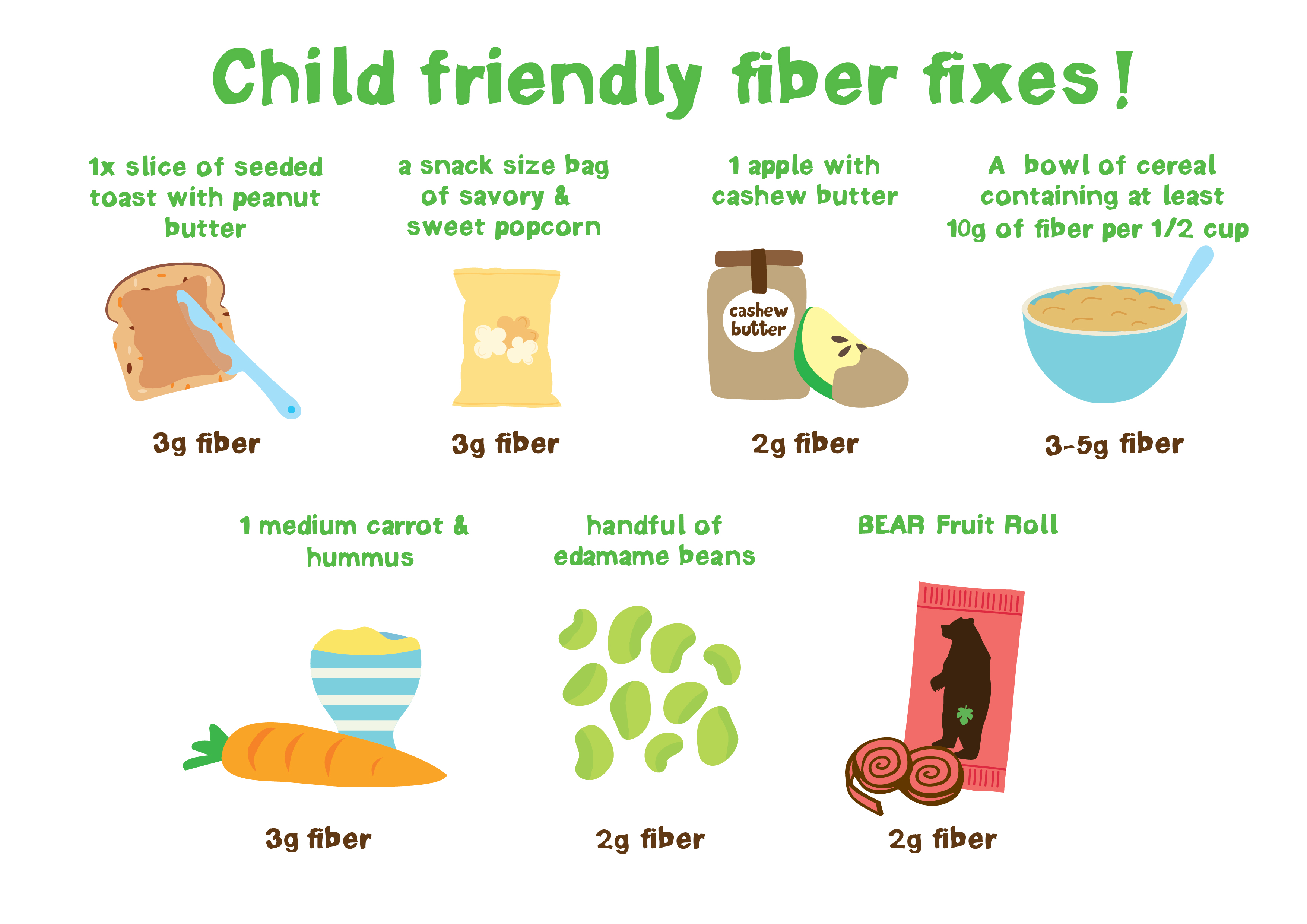I don’t know about you but in our house, it doesn’t take long for the conversation to turn to the subject of poo and all the hilarity and noises that go along with it. The fact that it is such a taboo subject seems to make them want to talk about it loudly especially when you’re in nice places to eat with people you hardly know!
So, I figure why not turn all this obsession with bowel habits into a positive. Do they know what makes a really great poo or what it means when their bowels start making noises? Surely this is an opportunity to tell them how cool fiber is and all the wonderful ways in which it can help them whether that’s by making them more healthy or adding to their street cred.
Fiber doesn’t often make the headlines and yet its role in health, for both children and parents is well researched and very compelling.
What is fiber?
It is the edible parts of plants which we can’t digest; these are types of carbohydrate that pass into our large bowel where they become the food for the trillions of bacteria that inhabit our guts. If we feed these bacteria well, they continue to thrive, pushing out the bacteria which are less good for us and benefiting both us and our kids.
Why do your kids need it?
For children, fiber is essential to help regulate bowel movements and to prevent constipation. For later in life when they are adults there is research that shows it protects their hearts and reduces the risk of some cancers and type 2 diabetes.
As well as its role in keeping their bowel movements healthy, fiber also plays a role in keeping them full – which is a useful tool for kids who are struggling with excessive hunger between meals. It also slows the breakdown of other carbohydrates in our blood stream (a process referred to as the glycaemic index) which helps to regulate blood sugar levels (and I personally tend to like my children more when they’re regulated, rather than on a post party sugar rush)! Diet survey data shows our main sources to be breakfast cereals, bread and vegetables. Fiber is also found in fruit, wholegrains, beans, peas, lentils, nuts and seeds. A diet containing lots of different sources of fiber helps to keep your little ones gut bacteria thriving, both in number and diversity.
How much do we need?
*We need to be careful in the first couple of years of life as babies and toddlers have high energy requirements relative to their size for rapid growth and development – too much fiber can fill their tiny tummies prematurely, limiting their capacity to get in the nutrition they need. How you can help this is by making sure fruit and veg portions are appropriate and ensure that not all carbohydrates given are fibrous ones (e.g. white varieties of rice, pasta or potatoes without skins).
However, as kids get older, many do not meet their daily fiber requirements, and it’s the same for parents for that matter. Children often find it unappealing and of course recommendations like these are completely lost on them!
|
Age group |
Recommendation |
|
*2-5 years |
15g/day |
|
5-11 years |
20g/day |
|
11-16 years |
25g/day |
|
16 and over |
30g/day |
Making sense of the numbers
If you work on the basis that achieving 5 portions of fruit and veg a day gets you about half way there (10g fiber in total), try to include some high fiber breakfast cereal (at least 10g fiber/ 100g) -even if it’s mixed with other cereals to encourage consumption. Then if you include some wholegrain at either lunch or dinner (e.g. wholemeal spaghetti or wholemeal bread) you get to around 17g of fiber a day. The snacks below can then help get you across the line and as kids grow and portion sizes get bigger, their fiber intake increases.

When choosing foods, look for fiber labelling
High fiber means it has at least 6g fiber per 100g and a source of fiber gives at least 3g fiber per 100g. The portion you give your child, or yourself for that matter, might not equal 100g but at least you know you’re making a worthwhile choice. So, given that fiber doesn’t have much street cred, how can we boost intakes and normalise its existence in the diets of the whole family? Let’s get practical.
Tips to boost fiber in our diets
- Choose fruit as a snack and keep the skin on if you can. Remember there are some other good fiber snacks shown in the picture, even nuts and seeds which often don’t get associated with fiber.
- Increase wholegrains – such as wholemeal bread or wholegrain cereal. Why not also try wholemeal flours or alternatives such as buckwheat or gram flour in baking – whether it be pancakes, or pizza bases the possibilities are endless. Wholegrain cereals also work well in trail mixes with dried fruit and savoury popcorn (also a wholegrain)!
- Mix and match white varieties of carbs with the wholegrain versions or choose 50/50 brands. It’s a good idea to build up fiber content of the diet slowly to allow the gut and taste buds to adapt.
- Oats – are really versatile and a great source of fiber – porridge, porridge fingers, healthy flapjacks made with fruit/dried fruit to decrease free sugar content, oats sneaked into pancakes, on top of lower sugar crumbles – there are loads of options.
- Pulses and lentils – are versatile and are also useful for making meat dishes go further. My personal favourite dishes are Moroccan chicken with chickpeas, chilli with kidney beans, lentil bolognaise and mixed bean quesadillas.
- Vegetables – keep going, keep offering in different formats, keep smiling and keep some in the freezer so you’ve always got some handy.
- Fermented foods – I haven’t been brave enough and they can be high in salt so you would need to watch portion size but if you think your children are game to try foods such as kimchi, sauerkraut or kefir milk then go for it - bacteria love them!
Hope that helps and gives you a few ideas.



